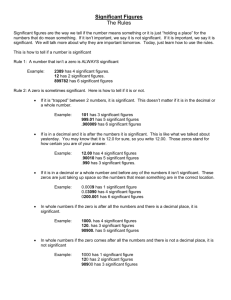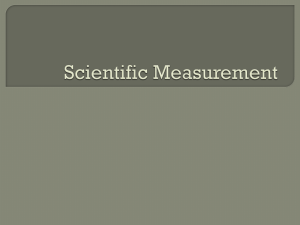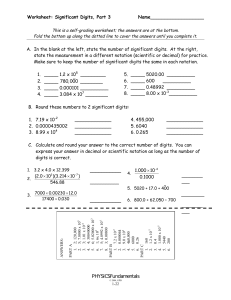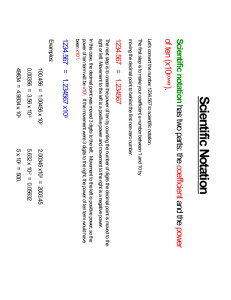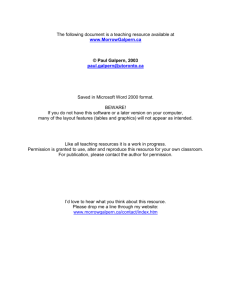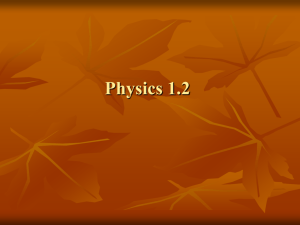Notes-C2-120.htm
advertisement
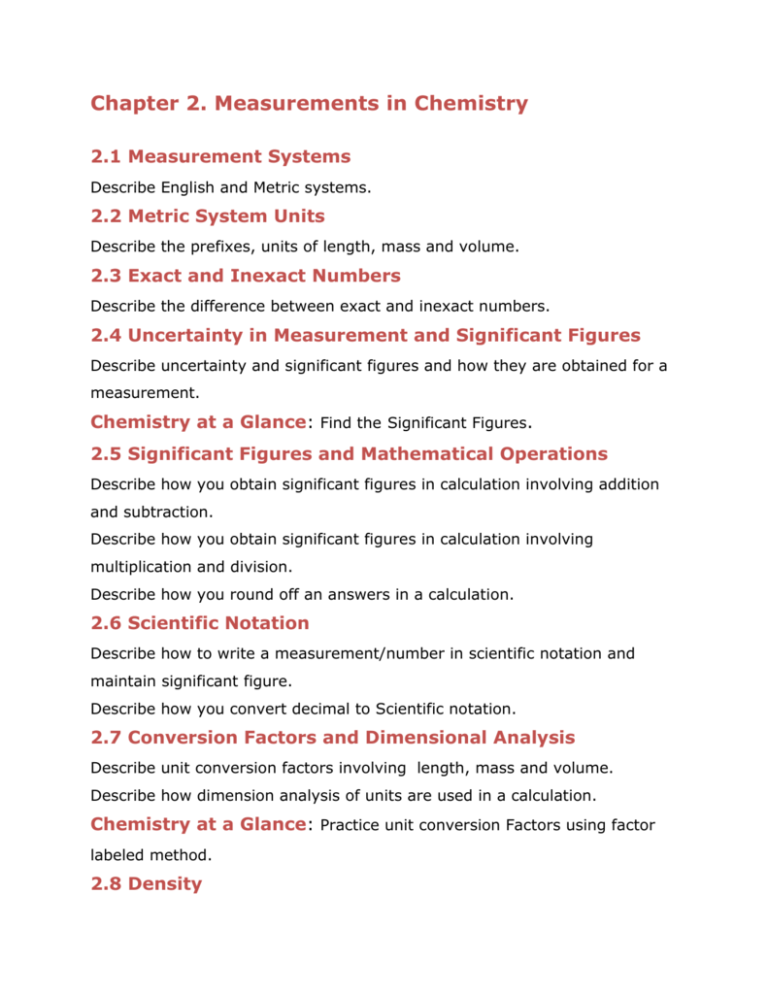
Chapter 2. Measurements in Chemistry 2.1 Measurement Systems Describe English and Metric systems. 2.2 Metric System Units Describe the prefixes, units of length, mass and volume. 2.3 Exact and Inexact Numbers Describe the difference between exact and inexact numbers. 2.4 Uncertainty in Measurement and Significant Figures Describe uncertainty and significant figures and how they are obtained for a measurement. Chemistry at a Glance: Find the Significant Figures. 2.5 Significant Figures and Mathematical Operations Describe how you obtain significant figures in calculation involving addition and subtraction. Describe how you obtain significant figures in calculation involving multiplication and division. Describe how you round off an answers in a calculation. 2.6 Scientific Notation Describe how to write a measurement/number in scientific notation and maintain significant figure. Describe how you convert decimal to Scientific notation. 2.7 Conversion Factors and Dimensional Analysis Describe unit conversion factors involving length, mass and volume. Describe how dimension analysis of units are used in a calculation. Chemistry at a Glance: Practice unit conversion Factors using factor labeled method. 2.8 Density Describe the density of materials how they are calculated. 2.9 Temperature Scales and Heat Energy Describe the Celsius, Kelvin and Fahrenheit temperature scales. Describe how a temperature in Celsius scale is converted to, Kelvin or Fahrenheit and vice versa. Describe heat energy and how they are measured in calories, dietary calories and joules. Chemical Connections: Describe Body Density and Percent Body Fat and Normal Human Body Temperature Describe elements Chapter 2. Measurements in Chemistry Chemistry at a Glance: Find the Significant Figures. 2.5 Significant Figures and Mathematical Operations Describe how you obtain significant figures in calculation involving addition and subtraction. Describe how you obtain significant figures in calculation involving multiplication and division. Describe how you round off an answers in a calculation. 2.6 Scientific Notation Describe how to write a measurement/number in scientific notation and maintain significant figure. Describe how you convert decimal to Scientific notation. 2.7 Conversion Factors and Dimensional Analysis Describe unit conversion factors involving length, mass and volume. Describe how dimension analysis of units are used in a calculation. Chemistry at a Glance: Practice unit conversion Factors using factor labeled method. 2.8 Density Describe the density of materials how they are calculated. 2.9 Temperature Scales and Heat Energy Describe the Celsius, Kelvin and Fahrenheit temperature scales. Describe how a temperature in Celsius scale is converted to, Kelvin or Fahrenheit and vice versa. Describe heat energy and how they are measured in calories, dietary calories and joules. Chemical Connections: Describe Body Density and Percent Body Fat and Normal Human Body Temperature Describe elements 2.1 Measurement Systems Measuring system is an integral part of any commerce or science to agree on the quantities of in their business and practices. In England a measuring system for the trading volumes was not properly standardized until the 13th century. For example, until gallon was made the standardized measure of volume consolidating different types of gallons (ale, wine and corn). In France and in 1799, a decimal system called metric system using centimeter, gram, and second (CGS system) for length, mass and time, respectively. All units are compared to a standard measure: meter was defined as being one ten-millionth part of a quarter of the earth's circumference and 100 centimeters equals a meter. Prefixes used in abbreviating measurements Prefixes allows simplifying the numbers with many zeros before and after the decimal place. Convert measurements to a unit that replaces the power of ten by a prefix: 6.80 x 10-9 m (6.08 nm) 7.14 x 10-6 s (7.14 m) 2.88 x 10-3 g (2.88 mg) 2.54 x 10-2 m (2.54 cm) 4.56 x 103 g (6.08 kg) 7.14 x 106 s (7.14 Ms) 2.2 Metric System Units-SI system Later a comprehensive Le Systeme international d'Unites (SI unit system) was created in 1960 and has been officially adopted by nearly all countries. SI units are based prefixes and upon 7 principal units, 1 in each of 7 different categories measurements. Category Length Mass Time Electric current Name metre kilogram second ampere Temperature kelvin Amount of mole Luminous intensity candela Abbrev. m kg s A K Mol cd 2.3 Exact and Inexact Numbers Exact Measurements For certain types of number associated with conversion factors are considered “exact.” For example, there are exactly 16 ounces in one pound. The number 16 would have as many decimal places or significant figures as needed. So one pound has 16.000000000000.... ounces. If you see any numbers you use in a calculation comes from a definition you could assume they are exact numbers. Exact Measurements In most of measurements the number associated with them are considered “inexact.” For example, if you measure the mass of a certain object on a balance and found that it has a mass of 25.0125 g, 25.013, 25.01 g 25.0 g or 25 g with a decimal place rounded off to a place at right depending on the decreasing accuracy of the balances used. If you use a number in a calculation which comes from a experimental measurement you could assume they are inexact numbers. Which types of numbers are considered “exact?” Below are the general rules. Metric to metric system conversion factors are exact 1. e.g. 1 m = 100 cm or 1 m/100 cm (In this conversion, 1 and 100 are both exact.) Conversions between English and Metric system are generally NOT exact. Exceptions will be pointed out to you. 2. e.g. 1 in = 2.54 cm exactly (1 and 2.54 are both exact.) 3. e.g. 454 g = 1 lb or 454 g/1 lb (454 has 3 sig. fig., but 1 is exact.) An example of an extensive property is a. freezing point. b. color. c. length. d. density. a b c d e Clear 2.4 Uncertainty in Measurement and Significant Figures An inexact numbers always comes out of an experimental measurement. They have been rounded off to show the uncertainty in the measurement. For example, if you measure the mass of a certain object on a balance and found that it gives a mass of 25.0125 g, 25.013, 25.01 g 25.0 g or 25 g with a decimal place rounded off to a place at right depending on the decreasing accuracy of the balances used. A measurement is always written down after considering the instrumental uncertainties. The uncertainly of a measurement could be conveniently expressed as a significant figure (SF). The right most digit in 25.0125 g which is 5 at the 4th decimal place is considered uncertain digit. Describe uncertainty and significant figures and how they are obtained for a measurement. The significant figure for this inexact number is obtained counting the other digits to the left from the uncertain digit. Therefore, 25.0125 g would have 6 significant figures: 25.013 (5 SF) , 25.01 g (4 SF) 25.0 (3 SF) g and 25 g( 2 SF). Lower the SF, higher the uncertainty of the number and less accurate. GENERAL RULES FOR FIGURING WHICH NUMBERS are significant. 1. ZEROS used to "place" the decimal are NOT significant figures: 0.015 g = 2 SF 2. LEADING ZEROS BEFORE all the digits are NOT significant: 000340 = 3 SF and 0.000216 g = 3 SF 3. TRAILING ZEROS after all the digits are SIGNIFICANT:1.500 g= 4 SF 4. SANDWICH ZERO WITHIN a number are SIGNIFICANT: 0.0105 g = 3 SF and 10.5 g = 3 SF 0.027 g = 2 SF (LEADING zeros BEFORE all the digits are NOT significant) 2.600 m = 4 SF (TRAILING zeros after all the digits are SIGNIFICANT) 210.05 s = 5 SF (SANDWICH zeros WITHIN a number are SIGNIFICANT) 0.0306 Kcal = 3 SF (LEADING zeros BEFORE as well as SANDWICH zeros WITHIN are SIGNIFICANT) How many significant figures are in the following numbers: a) 0.0945 (3 SF) b) 83.22 (4 SF) c) 106 (3 SF) d) 0.000130 (3 SF) Deduce the number of significant figures contained in the following: a) 16.0 cm (3 SF) b) 0.0063 m (2 SF) c) 100 km (3 SF) d) 2.9374 g (5 SF) e) 1.07 lb/in2 (3SF) How many significant figures are in the following measurements? a) 25.9000g (6 SF) b) 102 cm (3 SF) c) 0.002 m (1 SF) d) 2001 kg (5 SF) e) 0.0605 s (3 SF) f) 21.2 m (3 SF) g) 0.023 kg (2 SF) h) 46.94 cm (4 SF) i) 453.59 g (5 SF) j) 1.6030 km (5 SF) Uncertainty, Error, Accuracy, and Precision of measurements Uncertainty is expressed in terms of the rounding off to a significant figure. e.g. 25.013 ( 5 SF) , 25.01 g ( 4 SF) 25.0 (3 SF) g and 25 g( 2 SF). Note that greater the number of significant figures, the greater the precision. Precision versus Accuracy: Precision = How close measurements agree: If you take more reading of the same measurement how close they are. e.g. 25.0125 g, 25.0124 g and 25.0126 g are more precise than 25.0225 g, 25.10127 g and 25.0326. Accuracy = how close measurement is to the true value: something could be precise but inaccurate if the value is off by calibration error. e.g. Measurements 25.0125 g, 25.0124 g and 25.0126 and the true value 25.0125 g are both precise and accurate. e.g. Measurements 25.0125 g, 25.0124 g and 25.0126 and the true value 25.0125 g are both precise and accurate. e.g. 25.0225 g, 25.10127 g and 25.0326 g and the true value 26.0125 g are neither precise nor accurate. 2.5 Significant Figures and Mathematical Operations Most of the experiments involve calculation of a answer (derived quantity) from basic measurements with various units to a complex quantity with derived units. A simple example would be calculation of velocity of an object (car) travelling certain distance 356.5 miles in a given time in 4.8 hours. Question is how we obtain a velocity with correct uncertainties (SF) corresponding to uncertainties of distance and the time. Some of derived quantities involve additions/subtractions and/or multiplication/division. General rules for significant figure in addition/subtraction: 1. When adding or subtracting numbers, all numbers must have the same units. 2. The answer can have no more decimals than the measurement with the fewest DECIMALS. 254 mL - 54.1 mL 208.1 mL (4 SF) 208 mL (3 SF) 125.4 g 2.54 g ====== 127.94 g 127.9 g (4 SF) Rounding Off Numbers 1. "extra" digit is LESS than 5-drop it. 2. "extra" digit is MORE than 5-ADD 1. 3. "extra" digit is 5 “Odd rule“ e.g. 2.535 is rounded as “2.54 4. "extra" digit is 5 “Even rule“ e.g. 2.525 is rounded as “2.52” Significant figures in multiplication/division calculations 1. When multiplications or divisions of numbers, all numbers must have the same units. 2. The answer can have no more significant figures than the measurement with the fewest SIGNIFICANT FIGURES. (231.54 * 43)/433.4 = 22.972358 (231.54 (5 SF) 43(2 SF) 433.4 (4 SF) = 22.972358 = 21 (2 SF) = 21 (2 SF) Calculate 3.21 cm x 15.091 cm =18.301 cm = Ans. 18.3 cm (3 SF) Calculate 3.82 x 1.1 x 2.003 = 8.416606 = Ans. 8.4 (2 SF) Calculate 13.87 ÷ 1.23 = 11.27642276 = Ans. 11.3 (3 SF) Calculate 0.095 ÷ 1.427 = 0.066573231 = Ans. 0.067 (2 SF) In a long calculation involving mixed operations, carry as many digits as possible through the entire set of calculations and then round the final result appropriately. For example, (5.00 / 1.235) + 3.000 + (6.35 / 4.0) =4.04858... + 3.000 + 1.5875=8.630829... 5=8.6 2.6 Scientific Notation Scientific notation uses power-of-10 to express an extremely large or small numbers. Scientific notation has a regular number with correct significant figure with a value between 1 to 10, and a power of 10 by which the regular number is multiplied. E.g. 0.067 is converted to scientific notation: 6.7 x 10-2 The table shows several examples of numbers written in standard decimal notation (left-hand column) and in scientific notation (right-hand column). Number in decimal form with significant digits color Scientific notation with correct significant digits 1,222,000.00 1.222 x 10 6 34,500.00 3.450 x 10 4 0.00003450000 3.45 x 10 -0.0000000165 -1.65 x 10 -5 -8 Scientific notation makes it easy to multiply and divide gigantic and/or minuscule numbers. To obtain the product of these two numbers (the coefficients) are multiplied, and the powers of 10 are added. This produces the following result: 2.56 x 1067 x -8.333 x 10-54 = (2.56 x -8.333)(1067 x-54) = (-21.33248)(1013) = (-21.3)( 1013) = (-2.13)(1014) = -2.13 x 1014 Now consider the quotient of the two numbers multiplied in the previous example: (3.46 x 10 57 ) / (9.431 x 10 -75 ) To obtain the quotient, the coefficients are divided, and the powers of 10 are subtracted. This gives the following: = ((3.46 / (9.431)) x (10 57/10-75)) = ((3.46 / (9.431)) x (10 = (3.46 /9.431)) x 10 57+75 = (3.46 /9.431)) x 10 57+75 = 0.366875199 x 10137 = (3.66875199 x 101 ) x 10137 = (3.67) x ( (101 ) x 10137) = (3.67 x (10138) = 3.67 x 10138 57x10-(-75)) 2.7 Conversion Factors and Dimensional Analysis Conversion Factors are used to convert a measurement to another with different units. They are used for the length, mass, area, volume, temperature, energy, force and time conversions as listed below: Conversion Factors Length Mass Area 1 ft =12 in 1 yd = 3 ft 1 mi 5280 ft = 1mi = 1.609km 1 in =2.54 cm 1 m =3.281 ft 1 lb = 16 oz 1 ton = 2000 lbs 1 lb = 453.59 g 1 1 1 1 Energy 1 cal = 4.18681 J Btu=1.05506E3 J 1 food cal = 1 kcal Pressure 1 atm = 760 torr 1 atm = 1.01325E5 Pa 1 mmHg = 1 torr 1 mmHg = 1.333E2 Pa 1 Psi = 6.89476E3 Pa Volume acre =4.048x10 m acre =4840 yd2 mile2=2.589x106 m2 mile2= 640 acres 3 2 1 1 1 1 gal = 4 qt qt = 2 pt gal = 3.785 L L = 103 mL 1 mL = 1 cm3 Time 60 min = 1 hr 24 hr = 1 day 365.25 days = 1 year Temperature ? K = (x) °C -273.15) ? °C = (x) K + 273.15 ? °C = (5/9) ((x)°F -32) ? °F = (9/5)(x)°C +32 Simple unit conversations using factor label method Length How many meters are in a 4 cm? Conversion factor: 1 cm = 10-2 m or 1 cm 1 cm = 10-2 m or Align the conversion factor to a cancel cm 10-2 m 4 cm 10-2 m 1 cm = 4 x 10-2 m How many inches are in 1 meter? Given the conversion factors 1 inch = 2.54 cm and 1 meter = 100 cm 1.00 m 100 cm 1m 1 in 2.54 cm = 39.37008 m = 39.3 m or 1.00 m x 100 cm 1m x 1 in 2.54 cm = 39.37008 m = 39.3 m Note digits in blue are exact and was not considered for SF Convert 2.4 meters to centimeters (240 cm or 2.4 x 102 cm) Mass How many grams (g) in 150 pounds (lb) given the equalities 1 lb = 0.454 kg and 1 kg = 1000 g? 150 lb 0.454 kg 1 lb 1000 g 1 kg = 68100 g = 6.81x 104 g Scientific notation allows to show SF clearly. Convert 65.5 centigrams to milligrams 655 mg) Convert 5 liters to cubic decimeters (5 dm3) The density of a substance is 2.7 g/cm3. What is the density of the substance in kilograms per liter? 2.7 kg/L 2. A car is traveling 65 miles per hour. How many feet does the car travel in one second? 3. The density of water is one gram per cubic centimeter. What is the density of water in pounds per liter? 4. How many basketballs can be carried by 8 buses? 1 bus = 12 cars 3 cars = 1 truck 1000 basketballs = 1 truck Practice Problem Answers: 1. a. b. c. d. 240 cm 655 mg 5 dm3 2.7 kg/L 2. 95 ft/sec 3. 0.45 lb/L 4. 32 000 basketball (1)2 cm2 = (10-2)2 m2 1 cm2 = 10-4 m2 Volume unit: m3 is the base unit of volume. 1 cm = 10-2 m cube each number and unit in the conversion factor (1)3 cm3 = (10-2)3 m3 1 cm3 = 10-6 m3 Describe how dimension analysis of units are used in a calculation. Chemistry at a Glance: Practice unit conversion Factors using factor labeled method. 2.8 Density Describe the density of materials how they are calculated. 2.9 Temperature Scales and Heat Energy Describe the Celsius, Kelvin and Fahrenheit temperature scales. Describe how a temperature in Celsius scale is converted to, Kelvin or Fahrenheit and vice versa. Describe heat energy and how they are measured in calories, dietary calories and joules. Chemical Connections: Describe Body Density and Percent Body Fat and Normal Human Body Temperature Describe elements
